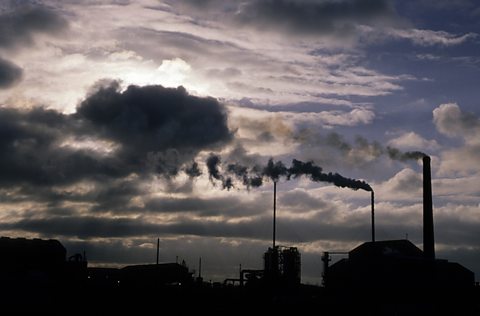Combustion of hydrocarbon fuels
hydrocarbonA compound that contains hydrogen and carbon only.fuelMaterial that is used to produce heat, like coal, oil or gas. can undergo complete combustionThe process of burning by heat. or incomplete combustion, depending on the amount of oxygen available.
complete combustionBurning in a plentiful supply of oxygen or air. Complete combustion of a hydrocarbon produces water vapour and carbon dioxide. happens when there is a good supply of air. Carbon and hydrogen atoms in the hydrocarbon fuel react with oxygen in an exothermicReaction in which energy is given out to the surroundings. The surroundings then have more energy than they started with so the temperature increases. reaction:
- carbon dioxideA gaseous compound of carbon and oxygen, which is a by-product of respiration, and which is needed by plants for photosynthesis. and water are produced
- energyThe capacity of a system to do work or the quantity required for mechanical work to take place. Measured in joules (J). For example, a man transfers 100 J of energy when moving a wheelbarrow. is given out
Carbon dioxide is an atmospheric pollutantA toxic chemical or object that causes damage to the land, air or water.. Incomplete combustion produces other pollutants.
Incomplete combustion
incomplete combustionBurning when there is a limited supply of air or oxygen. happens when the supply of air or oxygen is poor. Water is still produced, but carbon monoxidePoisonous gas produced during incomplete combustion. and carbon are produced. Less energy is released than during complete combustion.
For example, here is one possible equation for the incomplete combustion of propane:
propane + oxygen ‚Üí carbon + carbon monoxide + water
C3H8 + 3O2 ‚Üí C + 2CO + 4H2O
Soot
The carbon is released as fine black particleA general term for a small piece of matter. For example, protons, neutrons, electrons, atoms, ions or molecules.. We see this in smoky flames, and it is deposited as sootThe fine black particles, chiefly composed of carbon, produced by incomplete combustion of coal, oil, wood, or other fuels.. Soot can cause breathing problems and it blackens buildings. It may block boilers and other appliances, or cause a fire.

Carbon monoxide
Carbon monoxide is a toxicPoisonous. gas. It is absorbed in the lungs and binds with the haemoglobinThe red protein found in red blood cells that transports oxygen round the body. in the red blood cellThe blood cell which contains the pigment haemoglobin responsible for the transport of oxygen.. This reduces the capacity of the blood to carry oxygen. Carbon monoxide causes drowsiness, and affected people may fall unconscious or even die.